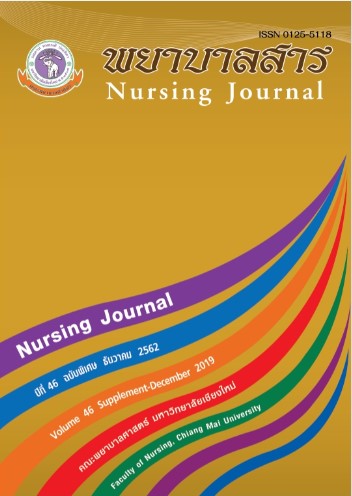Effects of Nordic Walking Exercise on Body Mass Index and Waist Circumference Among Overweight Older Persons
Keywords:
Nordic walking exercise, Overweight Older Persons, Body Mass Index, Waist CircumferenceAbstract
Overweight is defined as having more body fat, and results in chronic disease and health problems among older persons. Consistent practice of Nordic walking among older persons can reduce fat in the body. The objective of this experimental research was to examine the effects of Nordic walking on body mass index and waist circumference among overweight older persons. Subjects were 34 overweight older persons and were randomly assigned into the experimental and control group; 17 persons in the experimental group and 17 persons in the control group. Subjects in the experimental group participated in the Nordic walking exercise for 55 minutes a day, 3 days per week for 12 weeks, while those in the control group maintained their current exercise regimen. The instruments used in this study consisted of Nordic walking guidelines, a handbook on Nordic walking for overweight older persons, Nordic poles, a polar heart rate monitor, a data record form, a waist circumference measurement device and a bodyweight scale. Demographic data were analyzed using descriptive statistics and the hypotheses was tested using the t-test.
The results of study showed that:
- The Body mass index of the experimental group after the Nordic walking regimen was significantly lower than before the regimen (p < .01).
- Body mass index in the experimental group after the Nordic walking regimen was significantly lower than that of the control group (p < .05).
- The waist circumference of the experimental group after the Nordic walking regimen was significantly lower than before the regimen (p < .001).
- The waist circumference of the experimental group after the Nordic walking regimen was significantly lower than that of the control group (p < .01).
References
Prescription (8thed.). Philadelphia: Lippincott Williams & Wilkins.
Chatchawarat L, Lasuka D and Khampolsiri T. (2014). Review of periscope: The effect of Nordic
Walking exercise on obese elderly. Population health: Cross-cultural nursing and health care
Quality. Faculty of nursing. ChiangMai University. (In Thai)
Doungtipsirikul S, Sirisamut T, Tuntipisitkul K, Engsrisawang L and Terawattananon Y. (2013). Report
Of the 2013: Thai Health Status Survey under the Health Promotion Program for the Elderly and the Disabled. Bangkok: Watcharin PP. (In Thai)
Elisabeth, M. H., Basdevant, A., Finer, N. & Roman, G. (2012). Prevalence, Pathophysiology, Health Consequences and Treatment Options of Obesity in the Elderly: A Guideline obesity facts.5, 460–483. doi:10.1159/000341193
Figard, F.H., Fabre, N., Leonardi, A. & Schena, F. (2011). Efficacy of Nordic Walking in Obesity
Management. International journal of sports medicine. 32(6), 407-414.
Fritz T, K., Caidahl, M., Osler, Stenson C.G.O, Zierath, J.R., & Wandell, P. (2011).
Effects of Nordic walking on health-related quality of life in overweight individuals with Type 2 diabetes mellitus, impaired or normal glucose tolerance. Diabetic Medicine, 1363-1372. doi:10.1111/j.1464-5491.2011.03348.x.
Geriatric Medicine Thailand.(2004). A guide to assessing nutritional status in the elderly. Depertment
of medical services, Ministry of public health (In Thai)
Han, T.S., Tajar, A. & Lean, M.E.J. (2011). Obesity and weight management in the elderly.
BritishMedical Bulletin; 97, 169–196. doi:10.1093/bmb/ldr002
Janssen. I. (2007). Morbidity and mortality risk associatedwith an overweight BMI in older men and women. Obesity, 15(7), 1827–1840.
John P. P. (2008). Nordic Walking.University ofWisconcin. Retrived from
http://curriculum.dpsk12.org/physical_education/prof_dev/archives/NORDIC_WALKIN G_11- 3- 08.pdf
Mathus - Vliegen, E. M. H., Basdevant, A., Finer, N., Hainer, V., Hauner, H., Micic, D., Zahorska- Markiewicz, B. (2012). Prevalence, Pathophysiology, Health Consequences and Treatment Options of Obesity in the Elderly: A Guideline. Obesity Facts, 5(3), 460-483.
Ogden, C. L., Carroll, M. D., Kit, B. K., & Flegal, K. M. (2013). Prevalence of obesity among adults: United States, 2011-2012. NCHS Data Brief(131), 1-8.
Rungroj Thavorn.(2011). Indicator and range of values that indicate obesity.
Naresuan University (In Thai)
Schiffer, T., Knicker, A., Momtanarella, M. &Striider H.K. (2011). Mechanical and physiological effects of varying pole weights during Nordic walking compared to walking .Eur J Appl Physio, 111, 1121-1126. doi:10.1007/s00421-010-1739-5
Research. 7, 1-7.doi:10.1016/j.anr.2012.11.001
Tschentscher, M., Niederseer, D. &Niebauer, J. (2013). Health Benefits of Nordic Walking A
Systematic Review. American Journal of Preventive Medicine, 44(1), 76-84.doi:
10.1016/j.amepre.2012.09.043
Villareal, D.T., Apovian, C. M., Kushner, R.F. & Klein, S. (2014). Obesity in older adults. Technical review and position statement of the American Society for Nutrition and NAASO, The Obesity Society. The American journal of clinical nutrition, 925-926.
World Health Organization. (2011). Waist Circumference and Waist–Hip Ratio. Report of a WHO Expert Consultation. Geneva
Downloads
Published
How to Cite
Issue
Section
License
บทความที่ได้รับการตีพิมพ์เป็นลิขสิทธิ์ของวารสารพยาบาลสาร
ข้อความที่ปรากฏในบทความแต่ละเรื่องในวารสารวิชาการเล่มนี้เป็นความคิดเห็นส่วนตัวของผู้เขียนแต่ละท่านไม่เกี่ยวข้องกับมหาวิทยาลัยเชียงใหม่ และคณาจารย์ท่านอื่นๆในมหาวิทยาลัยฯ แต่อย่างใด ความรับผิดชอบองค์ประกอบทั้งหมดของบทความแต่ละเรื่องเป็นของผู้เขียนแต่ละท่าน หากมีความผิดพลาดใด ๆ ผู้เขียนแต่ละท่านจะรับผิดชอบบทความของตนเองแต่ผู้เดียว






